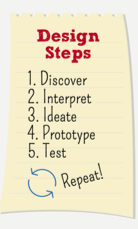As a group, we have been working on developing a learning design activity that connects to the BC science curriculum, specifically the grade 2 science and the water cycle. In our group, we each decided to focus on a different topic for our blog post and I decided to dive into the topic of design thinking.
Design Instruction was the topic out of all the options, that I had minimal knowledge on. I wanted to challenge myself and explore something new. So what is design instruction? I found many sources and definitions to define this topic, but the one that clarified it best for me was the following: “Design Thinking is a mindset and approach to learning, collaboration, and problem-solving. In practice, the design process is a structured framework for identifying challenges, gathering information, generating potential solutions, refining ideas, and testing solutions. Design Thinking can be flexibly implemented; serving equally well as a framework for a course design or a roadmap for an activity or group project.” (Havard University, Design thinking in Education 2022). My conclusion is that design thinking is a learning approach where one uses their situation and previous knowledge to help them craft solutions to a proposed challenge. What I enjoy about this learning process and approach is that it encourages more creative and critical thinking, to follow their curiosity. It is a style of incorporating inquiry-style learning and discovery into more learning situations making their learning more learner-directed. It is both an approach and a process (Havard, HGSE Infographic, 2022). When engaging in design learning, learners are to identify the challenge they are faced with, gather information, consider multiple solutions, and test and refine their ideas to find the best possible solutions to their challenge/problem.
The great thing about design thinking is that it can be incorporated into all different learning situations. It does require some freedom, and encouragement from teachers for it to work and be established effectively in a classroom, which is something we have the capacity for in our For our learning Design project on the water cycle. In regards to our proposed final assessment activity where students take on the role of a raindrop in the water cycle, they are simply given a small starting t, they are then allowed to use their design thinking to find how they want their final assignment to turn out as. They have to discover what they want to do, form ideas to do so and create a draft before creating their final product. Adapting this learning style would be a phenomenal way to encourage critical thinking and the development of their project so I am sure thinking design thinking should be used through this learning resource. I also think that design thinking could be a great way to introduce the topic of the water cycle. Students could be asked to brainstorm how they assume the water cycle might work and to develop a prototype or reasoning for how they think it functions and how it works. I think this would engage kids in the topic and since they would have minimal to no knowledge of the topic at this point it could help create a great class dissection on the water cycle and how it got to this point.
Any chance to learn or engage critically and problem-solve is fantastic. One thing I think I found interesting while researching my blog post was how it is a common practice I have used in my life without even directly trying to which I like. It is not something that has to be formally explained for it to be effective. To ensure all the steps are met sure explanations will help, but it is a great way to naturally approach challenges throughout life and see that you can try multiple solutions before finding the best one. I think it is a great way to learn and I will implement this directly into many of my future lessons.

Cheers!
Morgan

Leave a Reply